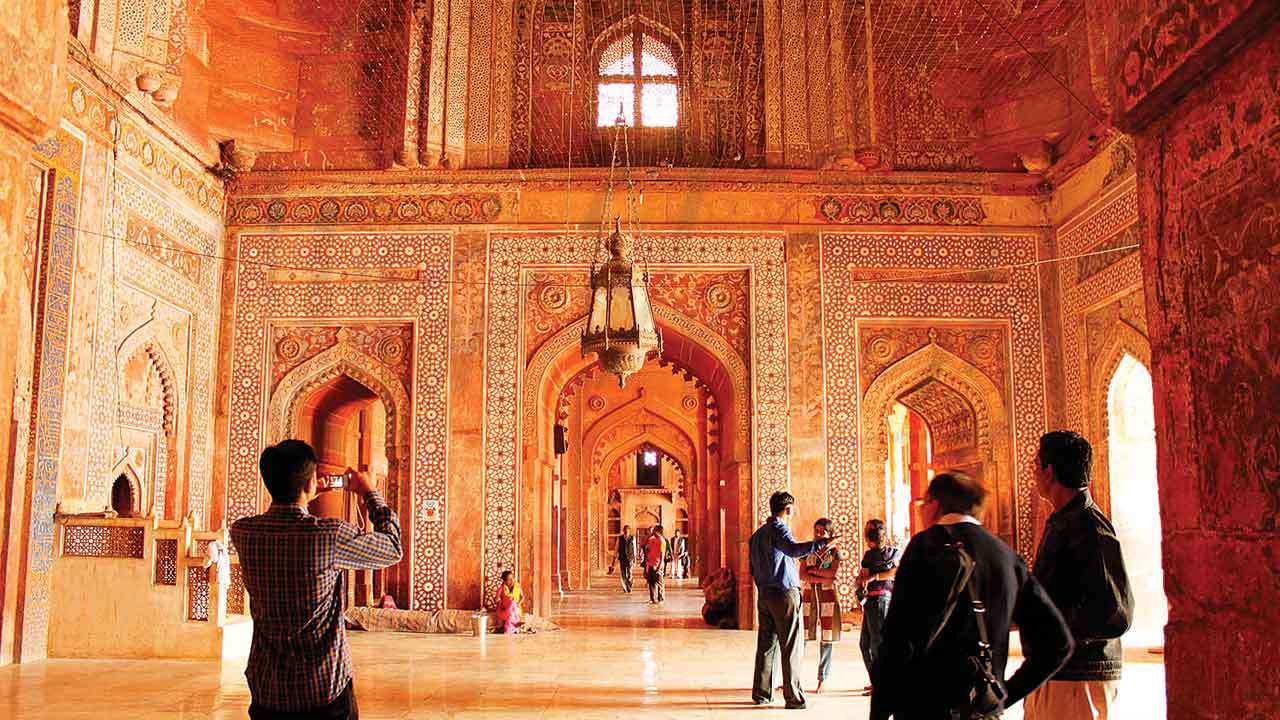
In the last piece, we had talked about some of the baseless stories that are spread by qualified guides at the Fatehpur Sikri. One of the gems that we had selected from their endless treasures of tall tales is the story that tells you that Akbar played hide and seek with his queens in two large halls that have been built behind the so-called Deewan-e-Khas. The story is told again and again, endlessly, the man spinning this yarn stands blocking your view of the ASI tablet that tells you that this building was the treasury. Next to the Treasury is an ornate pavilion, the guides tell you that Akbar’s astrologer sat here. The fact of the matter is that the place was most probably used by the royal treasurer or, as has been suggested, it was here that the king would be weighed in coins on his birthdays or on the anniversary of his coronation; the coins would then be distributed among the poor.
What never ceases to amaze me is the fact that no one, but no one, challenges these self-styled guardians of our heritage. No one asks them why would Akbar play hide and seek; did he not have more pressing affairs of the state to keep him engaged? Even if we were prepared to suspend disbelief and were to concede that the portly Akbar did find time for such frivolous diversions, why would he do this right in the middle of the administrative quarters and not in the relative privacy of the seraglio or in one of the royal garden or pavilions?
Have we, as a people, surrendered our ability to question, to doubt, to use our own common sense? I have never seen anybody stopping a guide to ask him ‘why would Akbar’s favourite queen have a separate kitchen’, ‘why would she cook her own food’, ‘could Akbar not afford to hire a maid for his favourite queen’. The questions never come from the naïve audience and the trickster impersonating a “guide” continues to pull out one rabbit after another from his proverbial hat.
There is an exquisitely carved two-storied structure to the southwest of the Seraglio. The seraglio has, for decades, been wrongly described as the Palace of Jodha Bai. Jodha Bai was in fact not even the wife of Akbar, She was the Queen of Jahangir, but these details have never impeded the fluent flow of verbiage that flows from our loquacious interpreters of the past.
This two-storied structure was built for two senior queens of Akbar: Ruqaiya Sultan and Salima Sultan. Ruqiya was Akbar’s first queen, she was the daughter of Hindal, the younger brother of Humayun, while Salima Sultan, the second Queen of Akbar was also a cousin, Akbar married her after the death of her husband Bairam Khan. The pavilion was commissioned for these two ladies, each occupied one floor of the building.
The guides have been palming this off as the palace of Birbal, one of the courtiers of Akbar and a close advisor. Again, no one has asked the question, no matter how close was a courtier to the King, will he live inside the royal palace, within walking distance of the Seraglio and the palace of the Queen Mother.
There is, in fact, no end to this chicanery. To the southwest of the palace of the two queens is an open quadrangle, enclosed to its north and south with a long arcaded corridor, the guides have been describing this area as the royal stables. Again, the gullible buy this tale without asking the basic question, why would anybody live in proximity of scores of horses? The stink of horse manure will drive everyone mad, especially during the blistering summers of Sikri and during the rainy season.
Such ideas are born of the imagination of poor peasants who have always slept next to their cattle for fear of cattle lifters. Why do I bring up the poor peasant into this story? I do so because the time when ASI first got interested in Fatehpur Sikri in 1892 and took up preservation and restoration work a little later, local youth, sons of peasants were engaged and gradually trained for the tasks at hand. Many of them later became unofficial guides for the tourists who started visiting the site in the early 20th century. Many among the present crop of old and young guides belong to the families of those first recruits. Despite the fact that many among them have picked up a smattering of one or more foreign languages, some have actually taken the trouble to study these languages, but those who have graduated to history from the grandfather’s tales that they grew up hearing, are few and far between.
Such is the fate of our protected monuments and their histories. We have close to 30 sites on the UNESCO world heritage list and another 40 in various stages of being inscribed on this list and yet one sees little effort to ensure that tourists, both local and foreign, are not short-changed with home-made histories and prejudiced mythologies being handed out as genuine historical accounts.
The author is a historian, and organises the Delhi Heritage Walk for children and adults